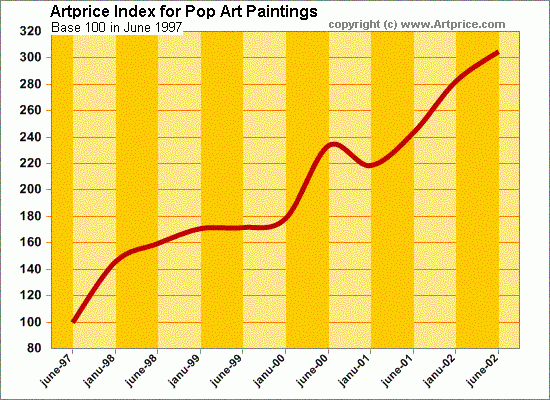The Pop Art as its Pop Star
[19/08/2002]
Barely half a century after they were created, the works of Andy WARHOL, Roy LICHTENSTEIN, Jasper JOHNS and Robert RAUSCHENBERG are already seen as collectors’ masterpieces. Prices rose by another 8% in the first six months of 2002. These classic works of the second half of the 20th century can fetch several million dollars at auction, even though they were initially produced for the mass market.
Firmly rooted in the media iconography of the day, pop art images are highly emblematic. While some artists made reference to the symbols and icons of fifties and sixties America, others based their work on everyday consumer products to create messages accessible to as wide an audience as possible. Screen printing processes were used to achieve the mass circulation of cult images. The prices of these “popular” works are not always as democratic as might be suggested by the day-to-day symbols they represent. Although the pop art movement blurred the distinction between fine art and commercial art techniques, the prices they fetch can put off most art enthusiasts. But despite the record prices obtained for certain artists, pop art sells well (no-sales of less than 13% in 2001) and prices have been rising steadily since 1997. This predominantely US movement tends to attract mainly US buyers. Though everything produced in the US finds its way onto export markets — and art is no exception— European collectors often lack the financial clout to outbid their US competitors at major auctions.
As shown by the prices fetched by New York pop artist Andy WARHOL, pop art and dollar bills go hand in hand. At an auction held by Sotheby’s New York in 1998, an “Orange Marilyn” sold for over 17.3 million dollars, consolidating the price levels for this artist, already riding high as a veritable star of the pop art world, and triggering rises in those of his peers. This work had originally been sold by Leo Castelli straight out of the studio for just USD 2,500. It was not until 1998 that Andy WARHOL moved into the major league. His price level rose 80% in that year, fuelling euphoria in the pop art market as a whole, where prices rose 43% on average over the same period. The phenomenon was greatly magnified by growing supply and demand. Catapulted into the speculative spotlight, this art movement, with its references to consumerism, itself became a consumer item. The increasingly intense pace of sales on the pop art market is demonstrated by both the rising number of lots and the decline in no-sales. All these factors reflect the appetite of US buyers for their domestic artists. Collectors have on average tripled their spend between 1997 and 2002.
Andy WARHOL’s use of multiple reproduction processes means there is no shortage of his production on the secondary market, and he now ranks fourth by number of transactions; behind Pablo PICASSO, Marc CHAGALL and Joan MIRO. It is important to remember here that the Andy Warhol Factory was able to turn out around 2,000 works in six months. In other words, contrary to popular opinion, scarcity is not always the key factor determining the price of a work of art. Artists’ price levels are in fact often boosted by a combination of high supply and demand, and abundant production often bears witness to an artist’s popularity. Even so, this “overproduction” was for a long time detrimental to the market in Andy WARHOL works. It was not until 1987, the year of the artist’s death and the beginning of the late 1980s speculative bubble, that the first good results began to be obtained at auction.
Supply is now shrinking, with many quality works hanging in American galleries. And some might say there are now limited opportunities for creating a pop art collection without breaking the bank. But in fact affordable prints, lithographs and other quality multiples are still freely available at auction. Working artists, such as James ROSENQUIST and Tom WESSELMANN, are particularly accessible given the absence of speculative purchases of their work to date.





 0
0
